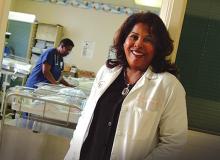It is fairly well appreciated that more than 1.7 million individuals living in the United States are now infected with HIV. What may be less appreciated by patients and physicians is that the impact of the epidemic on women has grown significantly over time.
In 2008, using a new national surveillance system, the Centers for Disease Control and Prevention reported that women comprised more than one-fourth (27%) of the 56,300 people estimated to have been newly infected with HIV in 2006. That is, an estimated 15,000 women were newly infected with HIV in 2006 alone (JAMA 2008;300:520-9).
 Photo credit: Courtesy Dr. Arlene D. Bardequez
Photo credit: Courtesy Dr. Arlene D. Bardequez
Arlene D. Bardeguez, M.D., M.P.H. says that the HIV epidemic has hit women the hardest. Ob.gyns. are in a position to identify HIV-infected women who could benefit from earlier monitoring and treatment, in turn, enabling those women to protect their partners and future children.
As ob.gyns. we care for women of all ages, from adolescents through women in their senior years. Therefore, we are in the unique position to be able to identify HIV-infected individuals who could benefit significantly from early monitoring and treatment, and to decrease the risk of transmission on a broader level. We can protect our patients, and they in turn can protect their partners and future children. This is a tremendous opportunity that we should not miss.
In 2006, the CDC moved away from HIV testing recommendations that were risk based and advised routine screening for HIV infection for all patients 13-64 years. It recommended that physicians notify their patients that testing will be performed unless they decline.
The American College of Obstetricians and Gynecologists weighed in the next year, saying that universal testing with patient notification is more effective in identifying infected patients than is targeted risk-based testing, largely because many women found to be infected with HIV did not consider themselves to have been at risk. Opt-out testing is less cumbersome, ACOG pointed out, because it removes the requirement for lengthy pretest counseling and for detailed, testing-related informed consent.
A 2007 survey of almost 400 medical staff at San Francisco General Hospital, which serves a population with a high HIV prevalence, showed that clinicians in obstetrics/gynecology and HIV infectious disease specialists were significantly more likely to routinely test their patients than were physicians in other specialties (J. Acquir. Immune Defic. Syndr. 2009;50:114-6).
As the authors say, however, this isn’t surprising given the fact that ACOG, the CDC, and other national organizations have long called for universal prenatal HIV testing.
Other studies have suggested that compliance with the CDC recommendations is low – that many ob.gyns. as well as other primary care physicians – do not routinely offer HIV testing outside of the prenatal context. Even in high prevalence areas such as New Jersey, we have documented that many providers miss the opportunity to offer the test to all their patients, deeming them unlikely to be infected. This approach hinders early access to care for potentially infected patients and fails to address an unknowing risk of transmission to partners.
We need to think differently.
We do not ask patients: Do you want a chlamydia test? A Pap smear? A cholesterol test? We tell them, instead, that we’re going to check their cholesterol levels, or that it’s time for their Pap smear, or that we’d recommend a chlamydia test. We need to present HIV testing in the same way – as a normal and routine part of medical care, a part of the routine battery of tests that will be performed unless the patient declines. Studies have shown, interestingly, that more patients accept recommended HIV testing when they know it’s routinely offered to everyone, without an assessment of risk.
Furthermore, we need to do so in spite of race and in patients of all ages, with all the generations of women whom we see.
As ob.gyns., we must be cognizant of the changing face of HIV infection in women in the last 30 years and realize the unique challenge that we now face as the infection encompasses patients from a broader age spectrum than just those in their reproductive years. We have witnessed both an increased number of HIV infections in the older population and increased survival among individuals on highly active antiretroviral therapy (HAART), including those who were perinatally infected.
We also must appreciate that women who are engaged in a relationship with a known HIV-infected partner, regardless of their age, can prevent acquisition with barrier methods such as condom use or postexposure prophylaxis as delineated by the CDC for serodiscordant couples. In the near future, based on recent reports of effectiveness, women also may be able to utilize microbicides to prevent HIV transmission.

